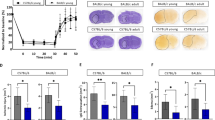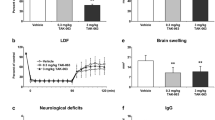Abstract
Adenosine monophosphate-activated protein kinase (AMPK) is an evolutionary conserved energy sensor sensitive to changes in cellular AMP/ATP ratio which is activated by phosphorylation (pAMPK). pAMPK levels decrease in peripheral tissues with age, but whether this also occurs in the aged brain, and how this contributes to the ability of the aged brain to cope with ischemic stress is unknown. This study investigated the activation of AMPK and the response to AMPK inhibition after induced stroke in both young and aged male mice. Baseline levels of phosphorylated AMPK were higher in aged brains compared to young mice. Stroke-induced a robust activation of AMPK in young mice, yet this response was muted in the aged brain. Young mice had larger infarct volumes compared with aged animals; however, more severe behavioral deficits and higher mortality were seen in aged mice after stroke. Inhibition of AMPK with Compound C decreased infarct size in young animals, but had no effect in aged mice. Compound C administration led to a reduction in brain ATP levels and induced hypothermia, which led to enhanced neuroprotection in young but not aged mice. This work demonstrates that aging increases baseline brain pAMPK levels; aged mice have a muted stroke-induced pAMPK response; and that AMPK inhibition and hypothermia are less efficacious neuroprotective agents in the aged brain. This has important translational relevance for the development of neuroprotective agents in preclinical models and our understanding of the enhanced metabolic stress experienced by the aged brain.





Similar content being viewed by others
References
Abete P, Cacciatore F, Testa G, Della-Morte D, Galizia G, de Santis D, Calabrese C, Cioppa A, Ferrara N, Rengo F (2010) Ischemic preconditioning in the aging heart: from bench to bedside. Ageing Res Rev 9:153–162
Alexis NE, Back T, Zhao W, Dietrich WD, Watson BD, Ginsberg MD (1996) Neurobehavioral consequences of induced spreading depression following photothrombotic middle cerebral artery occlusion. Brain Res 15:273–282
Anyanwu EC (2007) Neurochemical changes in the aging process: implications in medication in the elderly. Scientific World J 7:1603–1610
Apfeld J, O’Connor G, McDonagh T, DiStefano PS, Curtis R (2004) The AMP-activated protein kinase AAK-2 links energy levels and insulin-like signals to lifespan in C. elegans. Genes Dev 18:3004–3009
Baquer NZ, Taha A, Kumar P, McLean P, Cowsik SM, Kale RK, Singh R, Sharma D (2009) A metabolic and functional overview of brain aging linked to neurological disorders. Biogerontology 10:377–413
Canto C, Gerhart-Hines Z, Feige JN, Lagouge M, Noriega L, Milne JC, Elliott PJ, Puigserver P, Auwerx J (2009) AMPK regulates energy expenditure by modulating NAD + metabolism and SIRT1 activity. Nature 458:1056–1060
Culmsee C, Monnig J, Kemp BE, Mattson MP (2001) AMP-activated protein kinase is highly expressed in neurons in the developing rat brain and promotes neuronal survival following glucose deprivation. J Mol Neurosci 17:45–58
Fulco M, Sartorelli V (2008) Comparing and contrasting the roles of AMPK and SIRT1 in metabolic tissues. Cell Cycle 7:3669–3679
Gonzales RA, Brown LM, Jones TW, Trent RD, Westbrook SL, Leslie SW (1991) N-methyl-d-aspartate mediated responses decrease with age in Fischer 344 rat brain. Neurobiol Aging 12:219–225
Grabowski M, Brundin P, Johansson BB (1993) Paw-reaching, sensorimotor, and rotational behavior after brain infarction in rats. Stroke 24:889–895
Hardie DG (2007) AMP-activated/SNF1 protein kinases: conserved guardians of cellular energy. Nat Rev Mol Cell Biol 8:774–785
Hardie DG, Hawley SA (2001) AMP-activated protein kinase: the energy charge hypothesis revisited. Bioessays 23:1112–1119
Hawley SA, Davison M, Woods A, Davies SP, Beri RK, Carling D, Hardie DG (1996) Characterization of the AMP-activated protein kinase kinase from rat liver and identification of threonine 172 as the major site at which it phosphorylates AMP-activated protein kinase. J Biol Chem 271:27879–27887
Howitz KT, Bitterman KJ, Cohen HY, Lamming DW, Lavu S, Wood JG, Zipkin RE, Chung P, Kisielewski A, Zhang LL, Scherer B, Sinclair DA (2003) Small molecule activators of sirtuins extend Saccharomyces cerevisiae lifespan. Nature 425:191–196
Imai S (2007) Is Sirt1 a miracle bullet for longevity? Aging Cell 6:735–737
Jung JE, Lee J, Ha J, Kim SS, Cho YH, Baik HH, Kang I (2004) 5-Aminoimidazole-4-carboxamide-ribonucleoside enhances oxidative stress-induced apoptosis through activation of nuclear factor-kappaB in mouse Neuro 2a neuroblastoma cells. Neurosci Lett 354:197–200
Khaliulin I, Clarke SJ, Lin H, Parker J, Suleiman MS, Halestrap AP (2007) Temperature preconditioning of isolated rat hearts—a potent cardioprotective mechanism involving a reduction in oxidative stress and inhibition of the mitochondrial permeability transition pore. J Physiol 581:1147–1161
Kim EK, Miller I, Aja S, Landree LE, Pinn M, McFadden J, Kuhajda FP, Moran TH, Ronnett GV (2004) C75, a fatty acid synthase inhibitor, reduces food intake via hypothalamic AMP-activated protein kinase. J Biol Chem 279:19970–19976
Krieger DW, Yenari MA (2004) Therapeutic hypothermia for acute ischemic stroke: what do laboratory studies teach us? Stroke 35:1482–1489
Kuramoto N, Wilkins ME, Fairfax BP, Revilla-Sanchez R, Terunuma M, Tamaki K, Iemata M, Warren N, Couve A, Calver A, Horvath Z, Freeman K, Carling D, Huang L, Gonzales C, Cooper E, Smart TG, Pangalos MN, Moss SJ (2007) Phospho-dependent functional modulation of GABA(B) receptors by the metabolic sensor AMP-dependent protein kinase. Neuron 53:233–247
Lazzaro MA, Prabhakaran S (2008) Induced hypothermia in acute ischemic stroke. Expert Opin Investig Drugs 17:1161–1174
Li J, McCullough LD (2010) Effects of AMP-activated protein kinase in cerebral ischemia. J Cereb Blood Flow Metab 30:480–492
Li J, Zeng Z, Viollet B, Ronnett GV, McCullough LD (2007) Neuroprotective effects of adenosine monophosphate-activated protein kinase inhibition and gene deletion in stroke. Stroke 38:2992–2999
Li X, Blizzard KK, Zeng Z, DeVries AC, Hurn PD, McCullough LD (2004) Chronic behavioral testing after focal ischemia in the mouse: functional recovery and the effects of gender. Exp Neurol 187:94–104
Liu D, Gharavi R, Pitta M, Gleichmann M, Mattson MP (2009a) Nicotinamide prevents NAD + depletion and protects neurons against excitotoxicity and cerebral ischemia: NAD + consumption by SIRT1 may endanger energetically compromised neurons. Neuromolecular Med 11:28–42
Liu F, Yuan R, Benashski SE, McCullough LD (2009b) Changes in experimental stroke outcome across the life span. J Cereb Blood Flow Metab 29:792–802
Ljubicic V, Hood DA (2009) Diminished contraction-induced intracellular signaling towards mitochondrial biogenesis in aged skeletal muscle. Aging Cell 8:394–404
Love S (2003) Apoptosis and brain ischaemia. Prog Neuropsychopharmacol Biol Psychiatry 27:267–282
Lyden PD, Allgren RL, Ng K, Akins P, Meyer B, Al-Sanani F, Lutsep H, Dobak J, Matsubara BS, Zivin J (2005) Intravascular cooling in the treatment of stroke (ICTuS): early clinical experience. J Stroke Cerebrovasc Dis 14:107–114
McCullough LD, Zeng Z, Blizzard KK, Debchoudhury I, Hurn PD (2005a) Ischemic nitric oxide and poly (ADP-ribose) polymerase-1 in cerebral ischemia: male toxicity, female protection. J Cereb Blood Flow Metab 25:502–512
McCullough LD, Zeng Z, Li H, Landree LE, McFadden J, Ronnett GV (2005b) Pharmacological inhibition of AMP-activated protein kinase provides neuroprotection in stroke. J Biol Chem 280:20493–20502
Mulligan JD, Gonzalez AA, Kumar R, Davis AJ, Saupe KW (2005) Aging elevates basal adenosine monophosphate-activated protein kinase (AMPK) activity and eliminates hypoxic activation of AMPK in mouse liver. J Gerontol A Biol Sci Med Sci 60:21–27
Nakatsu Y, Kotake Y, Hino A, Ohta S (2008) Activation of AMP-activated protein kinase by tributyltin induces neuronal cell death. Toxicol Appl Pharmacol 230:358–363
Nemoto S, Fergusson MM, Finkel T (2004) Nutrient availability regulates SIRT1 through a forkhead-dependent pathway. Science 306:2105–2108
Osiewacz HD (2002) Genes, mitochondria and aging in filamentous fungi. Ageing Res Rev 1:425–442
Petersen KF, Befroy D, Dufour S, Dziura J, Ariyan C, Rothman DL, DiPietro L, Cline GW, Shulman GI (2003) Mitochondrial dysfunction in the elderly: possible role in insulin resistance. Science 300:1140–1142
Pillai VB, Sundaresan NR, Kim G, Gupta M, Rajamohan SB, Pillai JB, Samant S, Ravindra PV, Isbatan A, Gupta MP (2010) Exogenous NAD blocks cardiac hypertrophic response via activation of the SIRT3-LKB1-AMP-activated kinase pathway. J Biol Chem 285:3133–3144
Qiang W, Weiqiang K, Qing Z, Pengju Z, Yi L (2007) Aging impairs insulin-stimulated glucose uptake in rat skeletal muscle via suppressing AMPKalpha. Exp Mol Med 39:535–543
Raval AP, Lin HW, Dave KR, Defazio RA, Della Morte D, Kim EJ, Perez-Pinzon MA (2008) Resveratrol and ischemic preconditioning in the brain. Curr Med Chem 15:1545–1551
Reznick RM, Zong H, Li J, Morino K, Moore IK, Yu HJ, Liu ZX, Dong J, Mustard KJ, Hawley SA, Befroy D, Pypaert M, Hardie DG, Young LH, Shulman GI (2007) Aging-associated reductions in AMP-activated protein kinase activity and mitochondrial biogenesis. Cell Metab 5:151–156
Ronnett GV, Kim EK, Landree LE, Tu Y (2005) Fatty acid metabolism as a target for obesity treatment. Physiol Behav 85:25–35
Ronnett GV, Ramamurthy S, Kleman AM, Landree LE, Aja S (2009) AMPK in the brain: its roles in energy balance and neuroprotection. J Neurochem 109(Suppl 1):17–23
Rosamond W, Flegal K, Furie K, Go A, Greenlund K, Haase N, Hailpern SM, Ho M, Howard V, Kissela B, Kittner S, Lloyd-Jones D, McDermott M, Meigs J, Moy C, Nichol G, O’Donnell C, Roger V, Sorlie P, Steinberger J, Thom T, Wilson M, Hong Y (2008) Heart disease and stroke statistics—2008 update: a report from the American Heart Association Statistics Committee and Stroke Statistics Subcommittee. Circulation 117:e25–e146
Shapira S, Sapir M, Wengier A, Grauer E, Kadar T (2002) Aging has a complex effect on a rat model of ischemic stroke. Brain Res 925:148–158
Suwa M, Nakano H, Radak Z, Kumagai S (2008) Endurance exercise increases the SIRT1 and peroxisome proliferator-activated receptor gamma coactivator-1alpha protein expressions in rat skeletal muscle. Metabolism 57:986–998
Tissenbaum HA, Guarente L (2002) Model organisms as a guide to mammalian aging. Dev Cell 2:9–19
Tota S, Awasthi H, Kamat PK, Nath C, Hanif K (2010) Protective effect of quercetin against intracerebral streptozotocin induced reduction in cerebral blood flow and impairment of memory in mice. Behav Brain Res 209:73–79
Turdi S, Fan X, Li J, Zhao J, Huff AF, Du M, Ren J (2010) AMP-activated protein kinase deficiency exacerbates aging-induced myocardial contractile dysfunction. Aging Cell 9:592–606
Vingtdeux V, Davies P, Dickson DW, Marambaud P (2010) AMPK is abnormally activated in tangle- and pre-tangle-bearing neurons in Alzheimer’s disease and other tauopathies. Acta Neuropathol. doi:10.1007/s00401-010-0759-x
Wang W, Yang X, Lopez de Silanes I, Carling D, Gorospe M (2003) Increased AMP:ATP ratio and AMP-activated protein kinase activity during cellular senescence linked to reduced HuR function. J Biol Chem 278:27016–27023
Weisova P, Davila D, Tuffy LP, Ward MW, Concannon CG, Prehn JH (2010) Role of AMP-activated protein kinase (AMPK) in cell survival and death responses in neurons. Antioxid Redox Signal. doi:10.1089/ars.2010.3544
Wenk GL, Walker LC, Price DL, Cork LC (1991) Loss of NMDA, but not GABA-A, binding in the brains of aged rats and monkeys. Neurobiol Aging 12:93–98
Wood JG, Rogina B, Lavu S, Howitz K, Helfand SL, Tatar M, Sinclair D (2004) Sirtuin activators mimic caloric restriction and delay ageing in metazoans. Nature 430:686–689
Zhou G, Myers R, Li Y, Chen Y, Shen X, Fenyk-Melody J, Wu M, Ventre J, Doebber T, Fujii N, Musi N, Hirshman MF, Goodyear LJ, Moller DE (2001) Role of AMP-activated protein kinase in mechanism of metformin action. J Clin Invest 108:1167–1174
Acknowledgment
This work was supported by the National Institute of Neurological Diseases and Stroke (NINDS; NS050505 and NS055215 to LDM)
Author information
Authors and Affiliations
Corresponding author
About this article
Cite this article
Liu, F., Benashski, S.E., Persky, R. et al. Age-related changes in AMP-activated protein kinase after stroke. AGE 34, 157–168 (2012). https://doi.org/10.1007/s11357-011-9214-8
Received:
Accepted:
Published:
Issue Date:
DOI: https://doi.org/10.1007/s11357-011-9214-8




